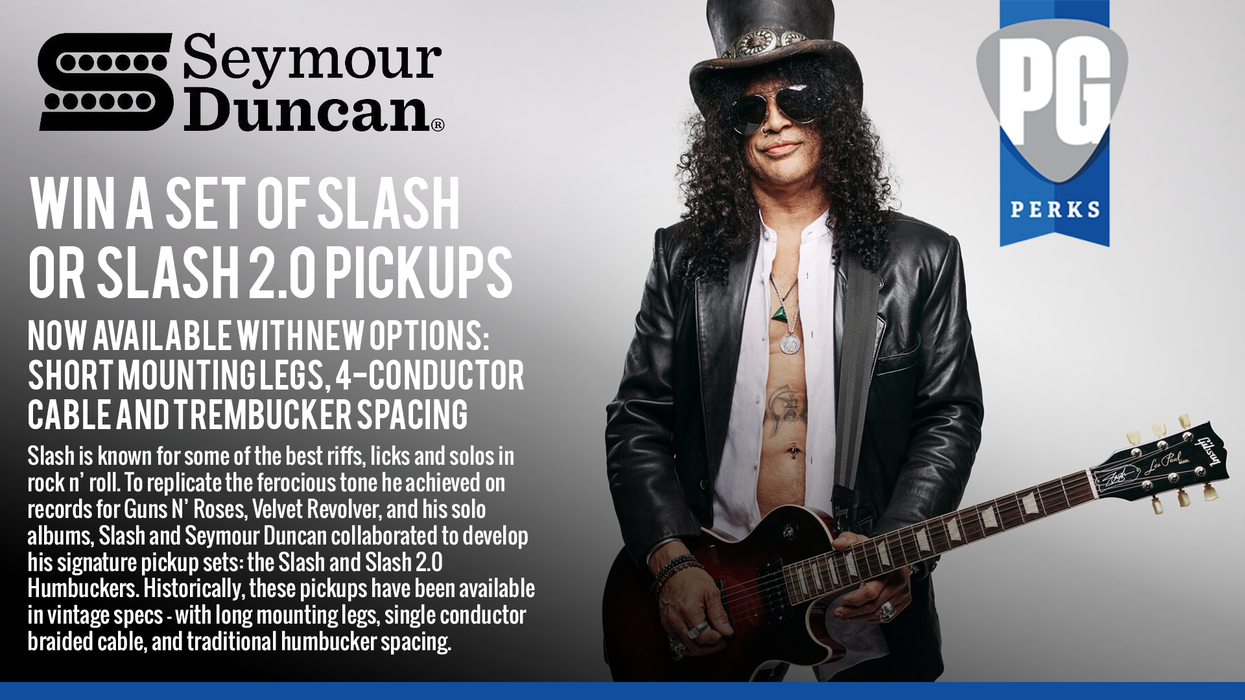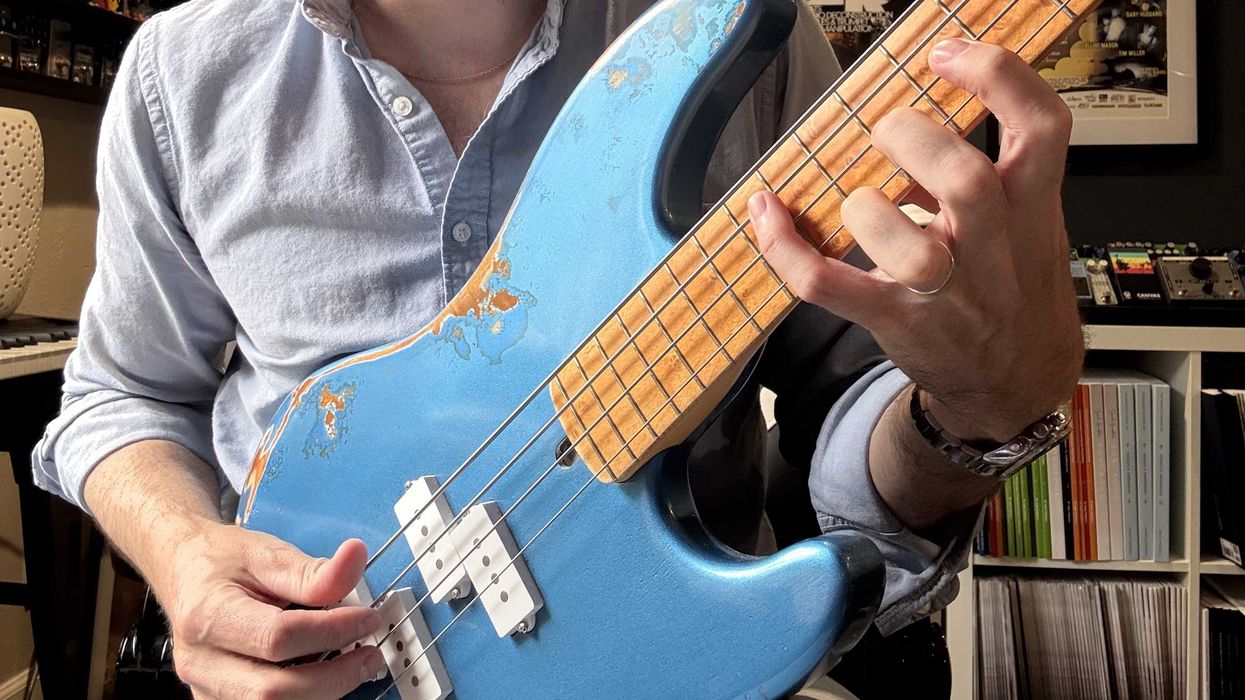In my previous column
[“Acoustic Amplification,Pt. 1,” August 2011], we talked
about the basic principals of
how an acoustic guitar operates.
Understanding these
principals will certainly be useful
when choosing the type of
pickup system that best suits
your needs. Equally important
in making the proper choice is
deciding on why you want to
amplify in the first place.
The first thing that comes to mind is that you probably want to be able to project more sound. If playing out is your thing, this certainly will be at or close to the top of your list of reasons to amplify. You should also carefully consider the type of venue (small club, large hall, or outdoors), as well as the type of gig (solo or band).
Of course, there are plenty of good reasons to amplify an acoustic instrument if you don’t play out. Style and technique, access to effects, home and studio audio recording, writing and arranging, practice methods, and teaching are all components of your musical activity that can benefit greatly from the use of amplification. We will explore all of these areas in greater detail later, but let’s tackle a live-performance scenario first.
Playing in front of an audience can be a truly fun and rewarding experience, but if you are not properly equipped, the experience can quickly become a nightmare of frustration and embarrassment. There is nothing worse than spending weeks or months preparing material for an important gig, only to have the characteristics of the room, the idiosyncrasies of the sound system (or the person running the system), or the failure of your own gear—either literally or functionally—totally obliterate all of the subtlety and substance of your performance. If it has happened once, you can be assured that it will happen again. Your only options to prevent this from ruining your day is to really understand how to choose and use the right gear, quit playing live, or take up heavy drinking!
Over the course of this column, we’ll examine some of the more typical live situations and consider what type of gear will be appropriate to deliver the great performance we all are looking for. This month, we’ll take a look at a solo performance in a small, intimate room with an attentive audience.
In the case of a small room that accommodates 100-150 people, the amplification equipment demands are pretty straightforward and generally not problematic. The house will often provide a small stage PA with no monitors, or ask the performer to bring their own PA or stage amplifier. You will not have to worry about monitors if the stage area is small enough and the amplification source will be close enough that there are no serious issues with delay. A boom-mounted microphone placed in front of your guitar will deliver everything you need. You should choose a good quality dynamic mic that has a directional—cardioid, supercardioid, or hypercardioid— pickup pattern, add a little reverb to the amp or PA, and call it a day.
The benefit of these directional mics is the isolation you get from their rear rejection, because rejection cuts down on feedback and ambient noise. Additionally, directional mics all exhibit what’s known as the “proximity effect.” In audio this is an increase in bass or low-frequency response when a sound source is close to a microphone. This can be a useful tool that allows you to “work the mic” like a good singer, adding variety and emphasis to certain parts of your music. You may also want to experiment with a small-diaphragm condenser mic for better sensitivity in the high end, but to avoid feedback problems or picking up unwanted ambient sound, stay away from the larger diaphragm condensers or ribbon mics in a live situation.
If sitting or standing still in front of a microphone feels too constraining to you, a hybrid or blended system for your guitar might be the ticket. These systems use a variety of pickup types (undersaddle, soundboard, or magnetic soundhole) in combination with a small onboard microphone that is either inside the guitar, or suspended in or near the soundhole. In this case, the pickup is generally the primary source and the microphone is blended into the mix to add some “air” or ambience from the internal reverberation present in the guitar.
This type of system can sound quite nice and there is usually not a feedback issue with an onboard mic at these volumes. If the signals are split and you have separate control over the volume and EQ of both sources, then you will be able to dial in a sound that offers more volume and dynamic range than you can get from a stage microphone. You will not be able to work the mic with this type of system, but you will be able to employ some of the tapping and body-percussion techniques that are common with many of today’s more innovative players.
It’s time to wrap it up for this month. We’ll explore some of the more challenging live performance situations next time, and hopefully provide some concepts and tools that will make you sound great no matter what type of live situation you are faced with.
 Larry Fishman holds
more than 30 patents in
transducer and musical
instrument design. He is
president and founder
of Fishman Transducers,
which he began in his
garage in 1981. In the early ’90s, he
also co-founded and managed Parker
Guitars (which was later sold to U.S.
Music Corp.) with his friend Ken Parker.
Larry Fishman holds
more than 30 patents in
transducer and musical
instrument design. He is
president and founder
of Fishman Transducers,
which he began in his
garage in 1981. In the early ’90s, he
also co-founded and managed Parker
Guitars (which was later sold to U.S.
Music Corp.) with his friend Ken Parker.
The first thing that comes to mind is that you probably want to be able to project more sound. If playing out is your thing, this certainly will be at or close to the top of your list of reasons to amplify. You should also carefully consider the type of venue (small club, large hall, or outdoors), as well as the type of gig (solo or band).
Of course, there are plenty of good reasons to amplify an acoustic instrument if you don’t play out. Style and technique, access to effects, home and studio audio recording, writing and arranging, practice methods, and teaching are all components of your musical activity that can benefit greatly from the use of amplification. We will explore all of these areas in greater detail later, but let’s tackle a live-performance scenario first.
Playing in front of an audience can be a truly fun and rewarding experience, but if you are not properly equipped, the experience can quickly become a nightmare of frustration and embarrassment. There is nothing worse than spending weeks or months preparing material for an important gig, only to have the characteristics of the room, the idiosyncrasies of the sound system (or the person running the system), or the failure of your own gear—either literally or functionally—totally obliterate all of the subtlety and substance of your performance. If it has happened once, you can be assured that it will happen again. Your only options to prevent this from ruining your day is to really understand how to choose and use the right gear, quit playing live, or take up heavy drinking!
Over the course of this column, we’ll examine some of the more typical live situations and consider what type of gear will be appropriate to deliver the great performance we all are looking for. This month, we’ll take a look at a solo performance in a small, intimate room with an attentive audience.
In the case of a small room that accommodates 100-150 people, the amplification equipment demands are pretty straightforward and generally not problematic. The house will often provide a small stage PA with no monitors, or ask the performer to bring their own PA or stage amplifier. You will not have to worry about monitors if the stage area is small enough and the amplification source will be close enough that there are no serious issues with delay. A boom-mounted microphone placed in front of your guitar will deliver everything you need. You should choose a good quality dynamic mic that has a directional—cardioid, supercardioid, or hypercardioid— pickup pattern, add a little reverb to the amp or PA, and call it a day.
The benefit of these directional mics is the isolation you get from their rear rejection, because rejection cuts down on feedback and ambient noise. Additionally, directional mics all exhibit what’s known as the “proximity effect.” In audio this is an increase in bass or low-frequency response when a sound source is close to a microphone. This can be a useful tool that allows you to “work the mic” like a good singer, adding variety and emphasis to certain parts of your music. You may also want to experiment with a small-diaphragm condenser mic for better sensitivity in the high end, but to avoid feedback problems or picking up unwanted ambient sound, stay away from the larger diaphragm condensers or ribbon mics in a live situation.
If sitting or standing still in front of a microphone feels too constraining to you, a hybrid or blended system for your guitar might be the ticket. These systems use a variety of pickup types (undersaddle, soundboard, or magnetic soundhole) in combination with a small onboard microphone that is either inside the guitar, or suspended in or near the soundhole. In this case, the pickup is generally the primary source and the microphone is blended into the mix to add some “air” or ambience from the internal reverberation present in the guitar.
This type of system can sound quite nice and there is usually not a feedback issue with an onboard mic at these volumes. If the signals are split and you have separate control over the volume and EQ of both sources, then you will be able to dial in a sound that offers more volume and dynamic range than you can get from a stage microphone. You will not be able to work the mic with this type of system, but you will be able to employ some of the tapping and body-percussion techniques that are common with many of today’s more innovative players.
It’s time to wrap it up for this month. We’ll explore some of the more challenging live performance situations next time, and hopefully provide some concepts and tools that will make you sound great no matter what type of live situation you are faced with.
 Larry Fishman holds
more than 30 patents in
transducer and musical
instrument design. He is
president and founder
of Fishman Transducers,
which he began in his
garage in 1981. In the early ’90s, he
also co-founded and managed Parker
Guitars (which was later sold to U.S.
Music Corp.) with his friend Ken Parker.
Larry Fishman holds
more than 30 patents in
transducer and musical
instrument design. He is
president and founder
of Fishman Transducers,
which he began in his
garage in 1981. In the early ’90s, he
also co-founded and managed Parker
Guitars (which was later sold to U.S.
Music Corp.) with his friend Ken Parker.
















